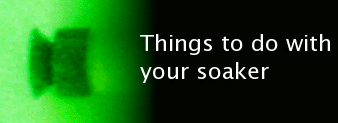
Super Soaker Tech
 |
 |
 |
 |

 |
 |
 |
 |
First off, the pressurized reservoir (PR) system:
This was the first system used in pressurized soakers. It's pretty basic, and is still used today.
Pros:
Allows for small design
Usually low priced
Cons:
Has extreme dropoff
Usually shorter ranges and less output than other soakers
How it works:
1. Air is pumped into the reservoir to pressurize the air sitting on top of the water.
2. When the trigger valve is opened, the pressurized air pushes water out the nozzle.

This system was used in several soakers created after the original super soaker (the SuperSoaker 50).
Pros:
Fewer pumps
Usually higher range and output than PR
Less dropoff
Cons:
There is still dropoff
Cost is usually higher than PR in this type of soaker
How it works:
1. Water is pumped into the PC, compressing the air sitting in the PC.
2. When the trigger valve is opened, the pressurized air pushes the water out the nozzle.
